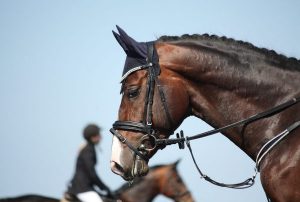
Do I have a good diet?
Dressage requires power, athleticism, concentration and obedience from the horse. The type of work required from a dressage horse could be compared to a cross between weight lifting and ballet in human terms and requires the development of muscle. Feeding to achieve all of these aims can be difficult, too much energy and the control and concentration may be lost and too little energy and the horse may lack the energy and impulsion required in the arena. Added to this each horse needs to be treated as an individual and other consideration such as condition, and temperament need to be taken into account. Dressage does not require huge intakes of energy and excess body fat will hinder performance and soundness.
The basis of any horse’s diet should be good quality fibre in the form of hay or pasture. At least 50% of the dressage horse’s diet should be forage even when competing at top level. Fibre is essential for the maintenance of a healthy gut. It reduces the incidence of stereotypic behaviour, as well as the likelihood of gastric ulcers and colic, along with helping maintain appetite and hydration. Highly digestible fibre sources such as the Super Fibres used in the Robank products also provide slow release energy that will not elicit an excitable behaviour in your horse.
When it comes to choosing a concentrate feed remember to take into account your horse’s workload, temperament, age and condition. For young horses just starting out or for mature horses in light work a low energy, high fibre feed should provide adequate energy levels. Feeds with low cereal grain content are ideal as these should be low in starch level to help avoid excitable behaviours. For horses in harder work but that have a tendency to be excitable a higher energy feed with a high fibre and fat content can help to provide the necessary levels of energy without the behaviour sometimes associated with traditional cereal based feeds.
For the calm (maybe lazy) horse a feed containing some fast release energy sources such as cereal grains may be helpful to provide some instant energy for short periods of intense work. Care should be taken however, that meals are not too large, as this can lead to undigested sugar and starch entering the hindgut, which can cause serious consequences such as colic and laminitis. Never feed more than 2kg of concentrate feed per meal. It is also very important to make sure the grains are processed in a way that makes them more available to the horse for digestion. Robanks utilizes state of the art micronizing technology to break down starch molecules in cereal grains making them more available for digestion and much safer to feed to horses.
If your horse loses weight easily, most of his additional concentrate feed should be in the form of a increased fat & highly digestible fibers. Very often laid-back horses tend to be good doers that are prone to gaining weight easily. If your horse keeps weight on well, then any additional energy will be converted to extra fat. In this situation, your horse needs a low intake feed that is moderate to low fat but still made up of highly digestible fibre sources— look for feeds which are formulated to be fed at low levels e.g. Robank Showtime. Regular weight taping and condition scoring will allow you to pick up on any changes in your horse’s weight and condition. As a guide you should be able to feel your horse’s ribs easily but not be able to see them. An ideal condition score is a 5 or 6 (on a scale of 1 to 9).
Like all horses the dressage horse will need vitamins and minerals to maintain health and performance. Not all minerals are the same however and in there inorganic state they are not very bio-available to the horse. A mineral’s bioavailability is the proportion of the mineral that, when ingested, actually gets absorbed by the body. The remaining amount is not absorbed and is removed as waste. Unfortunately most minerals in their natural or salt state are not easily absorbed and are therefore not very “bioavailable”. The movement of most minerals across the intestinal mucosa requires chelation. A chelated mineral that can be utilized by the body is one that has been bonded to two or more amino acids. A mineral in this “chelated state” allows easy passage through the intestinal wall into the blood resulting in increased metabolism of that mineral. In other words, when this mineral (e.g. zinc) is bound to an amino acid the combined particle (mineral plus amino acid) is perceived as food by the body, whereas the mineral itself, is not food. Your horses intestines are designed to allow food to pass through, but not raw (unbound) minerals. Robank utilizes high quality chelated minerals in all of its feeds.
By adhering to the principles of feeding plenty of fibre and choosing your horse’s feed according to workload, temperament and condition you can help to achieve a healthy horse with the energy needed to perform at their best.
